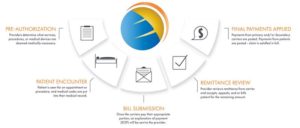Revenue Cycle Management (RCM) is an important part of understanding how providers track their claims submissions, denials, and payments. The RCM flow is the process healthcare facilities and providers use to track patient encounters and claims, from registration and appointment scheduling to the final payment of a balance.
This process is typically completed when the Electronic Remittance Advice (ERA) 835 transaction is routed from the Payer, back to the Provider, closing the claim payment loop.
Table of Contents
Patient Pre-Authorization, Eligibility & Benefits Verification
During patient pre-authorization, the insurance Provider or plan determines whether a prescription, service or medical device is approved under a member’s coverage. Depending on the scope and type of service, some insurers may require obtaining prior authorizations, especially when a desired treatment or procedure is generally not considered medically necessary. Medical emergencies may be an exception, as no pre-authorization can occur due to the time range in which the emergency occurs. Obtaining prior authorization is a crucial step in seeking payment for services, especially when it’s not a common procedure and wouldn’t generally be considered medically necessary outside of rare cases.
One of the biggest stalls in the medical billing cycle is issues due to member eligibility and benefit coverage. If prior authorization is obtained, Providers will need to pay close attention to the information they share and submit to the member’s insurance. They will need to review what their plan actually covers and any copay and accumulator information. Benefits eligibility can be discussed prior to making appointments to ensure proper in-network benefits.
Patient Encounter and Claim Submission
After the patient has been treated the claim must be submitted to the insurance carrier for payment. Practice management systems and medical coding specialists will prepare the claim with the correct Current Procedural Terminology (CPT) and International Classification of Diseases (ICD) codes to document the services performed during the patient encounter. Often, these codes will be used by insurance Providers to derive proper payments for the medical bill.
Once the carriers pay their appropriate portion, an explanation of payment (EOP) will be sent to the Provider. This EOP submission will include the payer’s responsibility total, the payment amounts, and any copays, coinsurance, or other amounts that would be the patient’s responsibility.
Submit Bill for Payment
After the EOPs are sent out, the claims will be reviewed, verified, and adjudicated by the insurance carrier. Adjudication is similar to the explanation of payment but it is the final determination of the Payer’s responsibility after their benefits and Provider payment portion is arranged.
The insurance carrier will review the claims and either pay the full amount, deny the claim, or negotiate to reduce the amount to be paid. Auto-adjudication can speed up this process by quickly paying or denying insurance claims without manually reviewing each one. This process is highly beneficial for commonly filed claims forms like routine and standard procedures.
Remittance Review
Remittance review occurs after claims submission and review, and before payments are posted. This step ensures quality assurance and that everything is accurate before posting payment. In this step, the Provider reviews remittance (payment) from the insurance carrier and either accept, appeals, or bills the patient for the remaining amount.
Remittance review is the final stage of review before anyone gets paid or billed. It’s very important to get in any last-minute appeals before payment is posted. This is also the stage in which those processing remittances can assist patients with any financial assistance via payment plans. The billing process can be quite complex, so it’s critical to bring clarity and accuracy during this time.
Payments
A claim paid in full will mean all of the payments have been collected and posted to the account. If the payment amount the patient is responsible for is beyond what they can afford to pay, arrangements may need to be made between a Provider’s billing department and the patient to work out a payment plan or settlement structure.
Claims that are late or not paid in full are at risk of going to a collections agency. If a claim was rejected for payment by the insurance carrier this will often begin an appeals process. During an appeal, the Provider will need to submit additional information to the Payer to explain why the claim should be paid and listing any exceptions, reasoning, and medically necessary situations.

Revenue Cycle Management
Revenue Cycle Management allows healthcare and insurance providers to preserve, manage, and improve patient care as it revolves around the billing process. RCM can reduce the time from service to receiving payment, simply by tracking each step diligently along the way. It can work within any IT system, ePHI system, or billing system.
To reiterate, the 5 basic stages of revenue cycle management are:
- Pre-authorization — The Provider determines which medical procedures, services, or devices are deemed medically necessary in regards to insurance.
- Services Performed — The patient is seen for medical services, procedures, or other appointments, and the appropriate codes are applied to their medical record.
- Bill is Submitted for Payment — An Explanation of Payment (EOP) is sent to the Provider after the insurance carrier pays their applicable portion of the bill.
- Remittance Review — Before payments are applied, the Provider reviews remittance and either accepts, appeals, or bills the patient for the remainder.
- Final Payment Applied — After everything has been processed and verified, the final payments are posted from patients and the claim is closed.
Smart Data Solutions knows how important it is to track a claims journey, from beginning to end. Our clients face challenges along the revenue cycle that we want to help alleviate with our advanced IT systems and machine learning processes, to ensure accurate claims processes and data.
